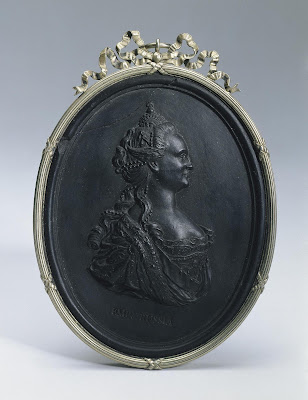 |
| Sèvres Manufactory Vase 1777-79 porcelain Hermitage, Saint Petersburg |
 |
| Derby Manufactory Bust of Zingara ca. 1782-1800 porcelain British Museum |
The so-called Zingara above was adapted from a famous 'ancient' statue in Rome, traditionally identified as an 'Egyptian' or 'Moorish' woman and displayed at Villa Borghese since the 17th century. That statue was shipped to the Louvre early in the 19th century following its purchase by Napoleon, and remains there today. It was – according to Francis Haskell in Taste and the Antique – "the product of some drastic doctoring of an early marble trunk, and in the eighteenth century Bernini was credited (on the basis of no serious evidence known today) with having made and added the bronze head, hands and feet. Early in the nineteenth century these were attributed to Algardi, and this although just possible (and constantly repeated) has never been proved and is quite unconvincing. The most likely creator of the statue in its present form is either the French sculptor Nicolas Cordier (1567-1612) who was much employed by the Borghese in producing just such work, or an artist working in his style."
 |
| Borghese Zingara |
"The Zingara was certainly very much admired in the seventeenth century, as is shown by its inclusion in Perrier's anthology, but its real fame became established in the eighteenth. Maffei, who acknowledged that it was 'deservedly held in great esteem', devoted most of his commentary on it to expressing his distaste for gypsies, but this attitude was unusual and tolerant amusement is the more common reaction. Although generally (but by no means always) known to be modern, it was the expression of the head 'with a Chin-cloth' that especially appealed. For Gibbon it had the 'true character of impudence and low cunning suitable to a fortune-teller' and for Moore 'a great look of some modern gypsies I have seen, who have imposed most egregiously on the self-love and credulity of the great'. Richard found her 'charming: one can see the fire coming out of her eyes with all the cunning of her state which is only on the look-out for dupes'. According to Baretti, the statue was not only 'much valued on account of its being a fine piece of sculpture, but also a representation of a character not to be met with in any other antique Remain but this.' . . . In the saloon at Stourhead in Wiltshire there is a marble copy (half life-size), and it was among the plaster and bronze statuettes sold in the last decades of the century in London and Rome. But it was the head alone that was most commonly reproduced, in France (there is a colossal example with porto venere drapery in the reserve collection at Versailles) and especially in England, in marble by itself, and as the head on marble chimney-piece herms, in Derby biscuit porcelain [illustrated above], in cameos and gems, in earthenware by Ralph and Enoch Wood, in black basalt by Wedgwood, and in sets of plaster casts made by Scheemakers, by Cheere and by Charles Harris. The head remained popular in the middle years of the nineteenth century when it was listed by Brucciani in his catalogue of plasters both under 'Modern Busts' and under 'Busts from the Original Antique'. However, by 1820 Clarac had dismissed it as characterless."
 |
| Sèvres Manufactory Relief-bust of Lucius Junius Brutus ca. 1794-1800 porcelain British Museum |
 |
| Wedgwood Manufactory Pegasus Vase (detail) modeled by John Flaxman 1786 jasperware British Museum |
 |
| Wedgwood Manufactory Pegasus Vase modeled by John Flaxman 1786 jasperware British Museum |
 |
| Wedgwood Manufactory Catherine II rewarding art and protecting commerce late 1780s jasperware medallion Hermitage, Saint Petersburg |
 |
| Wedgwood Manufactory Relief-portrait of Catherine II ca. 1780 black basalt medallion Hermitage, Saint Petersburg |
 |
| Wedgwood Manufactory Relief-portrait of Charles Linnaeus modeled by John Flaxman ca. 1775-80 jasperware medallion British Museum |
 |
| Wedgwood Manufacatory Relief-portrait of Captain Cook modeled by John Flaxman ca. 1775-80 jasperware medallion British Museum |
 |
| Wedgwood Manufactory Relief-portrait of Captain Cook modeled by John Flaxman 1784 jasperware medallion British Museum |
 |
| Doccia Manufactory Allegorical figure of Hope 1780s porcelain British Museum |
 |
| Doccia Manufactory Relief-portrait of Ercole III, Duke of Modena 1797 porcelain cameo British Museum |
 |
| Meissen Manufactory Statuette of Venus ca. 1743 porcelain Hermitage, Saint Petersburg |
 |
| Anonymous French Manufactory Inkstand with Cupid-Drummer 1774 porcelain Hermitage, Saint Petersburg |